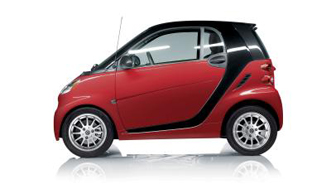Newest J.D. Power Study Determines Which Brand Has the Best Website

The brand might have some of the smallest units on the road, but J.D. Power and Associates determined the badge packs the most effective punch with its website.
J.D. Power’s 2013 Manufacturer Website Evaluation Study — Wave 1 revealed that the company with the best site is smart, scoring 845 on a 1,000-point scale.
Jeep ranked second with a score of 840, followed by Lincoln (835) and Acura (834).
Overall satisfaction with automotive brand websites averaged 812.
Reinforcing what analysts and service providers have said about OEM’s online presence, J.D. Power found new-vehicle shoppers are more likely to test drive a vehicle following a satisfying experience on a manufacturer’s website on either a desktop or tablet.
The semiannual study, now in its 14th year, measures the usefulness of automaker websites during the new-vehicle shopping process by examining four key measures (in order of importance): information/content, navigation, appearance and speed.
The ability of new-vehicle shoppers to find information on a website easily and quickly has a direct impact on their decision to continue to shop that vehicle.
For example, the study found that among automotive shoppers on desktops who are “delighted” with their experience on a manufacturer’s website (satisfaction index score of greater than 900 on a 1,000-point scale), 72 percent are more likely to test drive a vehicle after visiting the manufacturer website, compared with only 25 percent of “disappointed” shoppers (satisfaction index score of 550 or less).
“Finding the right balance of content, ease of navigation and site speed is what ultimately drives new-vehicle shopper satisfaction with the website,” said Arianne Walker, senior director of media and marketing solutions at J.D. Power.
“Satisfaction with a website increases the likelihood that shoppers will visit a dealership and test drive a vehicle,” Walker continued.
In addition to a website that works well across platforms, Walker said the key is for automakers to develop a site that is reflective of their brand image and is able to meet the needs of their shoppers.
“While there are some common elements across all websites, each site should have a unique look and feel and align with the brand’s image,” Walker said.
The study also found that tablet ownership has risen 23 percent during the past six months among consumers who evaluated a site and is further changing the device mix automakers must accommodate for their online shoppers.
To accommodate tablet device shoppers, J.D. Power indicated many automakers direct shoppers to a desktop version of their website. However, depending on the device and automaker, the firm pointed out shoppers may also be directed to a mobile version of the website.
Overall satisfaction among tablet users who are likely to be directed to a desktop website is 820, compared with 798 among those who are directed to a mobile website.
In addition, satisfaction is higher across all four measures when tablet users utilize a desktop website.
“Shoppers on a tablet are able to access all of the shopping information when they’re directed to a desktop website, compared with a mobile site,” Walker said. “However, it is critical that the desktop sites be designed to accommodate tablet navigational needs.”
While some shoppers are using their tablet to explore manufacturer websites while they’re on the go, the study finds that shoppers are more likely to access automotive information while at home (37 percent) than while shopping or running errands (16 percent).
Regardless of the location where they shop, 92 percent of new-vehicle shoppers who own a tablet, or own both a tablet and a smartphone, expect to have the same content available on a desktop website on all devices, according to J.D. Power’s study.
“Shoppers want the same content-rich experience, whether they’re on a desktop, tablet or smartphone,” Walker said. “The challenge for automakers is creating sites that meet the needs of shoppers across platforms.
“The industry has generally chosen to maintain two sites, rather than a third one for tablet shoppers, reducing the burden of maintaining and keeping information updated and consistent across three separate sites,” she went on to say.
The Manufacturer Website Evaluation Study — Wave 1 is based on responses from 10,006 new-vehicle shoppers who indicate they will be in the market for a new vehicle within the next 24 months. The study was fielded last November.
OEM Website Rankings on 1,000-Point Scale
—smart: 845
—Jeep: 840
—Lincoln: 835
—Acura: 834
—Porsche: 829
—Honda: 828
—Dodge: 827
—Chrysler: 823
—Kia: 819
—Hyundai: 818
—Infiniti: 817
—Cadillac: 816
—Fiat: 816
—Lexus: 816
—Ford: 814
—Jaguar: 814
—Mercedes-Benz: 813
—Mini: 812
—Industry Average: 812
—Mitsubishi: 811
—Volvo: 811
—Nissan: 810
—Subaru: 810
—Toyota: 806
—Mazda: 805
—Land Rover: 804
—Volkswagen: 799
—Buick: 797
—Chevrolet: 797
—Audi: 789
—Scion: 784
—GMC: 782
—Ram: 782
—BMW: 780
Continue the conversation with Auto Remarketing on both LinkedIn and Twitter.


